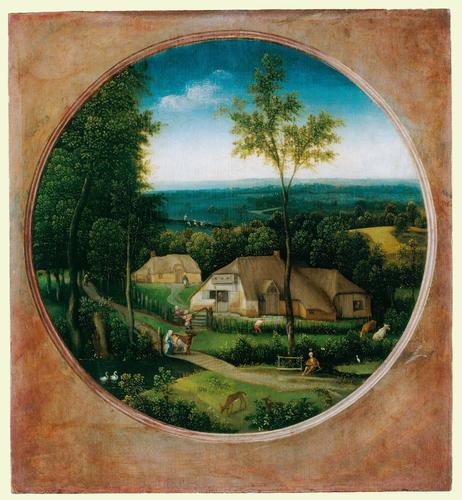Follower of Cornelis Massys (c. 1510-57)
Landscape c.1550
Oil on panel | 24.6 x 22.4 cm (support, canvas/panel/stretcher external) | RCIN 403378
West Closet, Hampton Court Palace
-
The younger son of Quinten Massys, Cornelis was born in Antwerp and, along with his brother Jan, became a master of the Guild of St Luke in 1531 after Quinten’s death. Until about 1500 landscapes played a subsidiary, supporting role to history and religious paintings in Flemish art. It was only in the early sixteenth century that scenes from nature began to have a serious artistic position in their own right, and Cornelis was one of the first painters to explore the possibilities of this, with fully detailed landscapes capable of conveying independent narratives through the inclusion of figures and animals. This example is cleverly conceived to fit into an illusionistic circular format. Painted within a ‘false’ moulding with a pink/green marbling effect, it has a seriousness that belies its small scale.
The tranquil scene is populated with figures engrossed in activity. In the background, below an almost dream-like idealised horizon, a shepherd looks after his sheep. The two houses at the centre of the composition convey a strong sense of homeliness and hard work, with figures depicted inside the foreground house, and a woman walking towards the door of the second. The middle and foreground areas are linked by the use of a bridge where a woman leading an ox and an ass crosses over. Natural order is maintained by the inclusion of a man hammering a peg into the fence separating the main house from a field containing two cows. The left-hand edge of the painting is beautifully framed by tall trees, hinting at a forest beyond. These are balanced by a single tree to the right of centre, which curves satisfyingly to mirror the main tree of the forest area, in front of which runs a narrow river, with two swans swimming peacefully along.
The artist gives the viewer every aspect of country life in this idyllic painting. Water, fresh air, forest, houses, animals and plants exist together so that landscape and figures interweave harmoniously. A serious note is added with the inclusion of a beggar sitting, shoeless, underneath a shrine fixed to the tree that stands alone. Below the shrine is a makeshift prayer-bench. The beggar is not kneeling at the bench, but his positioning, looking out of the picture, appears to be contemplative and engages the viewer with the fictional scene. He is included as a reminder of the less fortunate elements of society, and of the hope of salvation that comes through prayer. Consequently the circular scene contains a moral message as well as celebrating the wonders of fertile, well-maintained land; and human beings in control of, contemplating and giving thanks for their surroundings.
The painting appears in Pyne's illustrated 'Royal Residences, hanging in The Queen's Closet at Kensington Palace (RCIN 922154).
Catalogue entry adapted from Bruegel to Rubens: Masters of Flemish Painting, London, 2007Provenance
Acquired by Charles I from the Gonzaga collection, 1628
-
Creator(s)
Acquirer(s)
-
Medium and techniques
Oil on panel
Measurements
24.6 x 22.4 cm (support, canvas/panel/stretcher external)
43.6 x 41.5 x 4.6 cm (frame, external)








